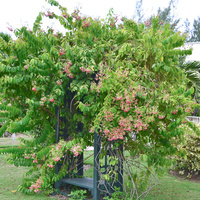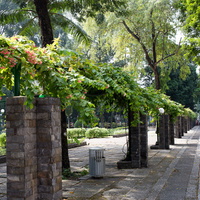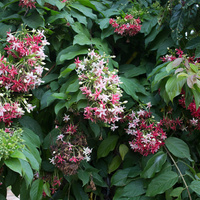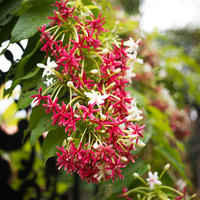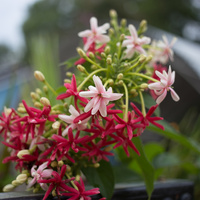Description
Ragoon creeper is a flowering vine and medicinal plant originating from the Old World tropics, in the region extending from India through Southeast Asia to Southern China.
It is a vigorous, much-branching plant, made up of cylindrical stems 10 to 20 m (33 to 66 ft) long that are green and softly hairy when young, becoming woody with age. These climb up, around and over vertical structures, eventually entwining and covering them with green foliage.
The leaves are oval with a pointed tip, up to 12 cm (4.5 in) long, reddish when they emerge, becoming dark green. They are arranged in pairs along the growing ends of the vine but fall off in the dry season to conserve water, leaving the stems partly bare and exposed until the rainy season, when the new leaves emerge.
Soon after the new leaves emerge, the plant comes into bloom, with clusters of small trumpet-shaped flowers arising at the tips of the vine. White when they open, they curiously change colour, becoming pink then finally red, though not all at the same time, resulting in clusters of flowers in all three colours.
The flowers are followed by dark brown, elongated-oval, five-winged seedpods up to 4 cm (1.5 in) long, each enclosing a single seed.
Use
Rangoon creeper is cultivated in warm-climate gardens for training on trellises and arbours and for growing up walls and fences, to quickly create a covering of dense foliage and blooms of colour. It may also be trained to become a natural awning for porches and verandas, for giving shade from the hot tropical sun.
General interest
Another curiosity of this plant is that when the leaf blades fall in the dry season, the stalks transform into stout, curved thorns that further assist the plant to climb.
Health use
According to 'Herbal plants: keeping our traditional wisdom alive', a UNESCO (United Nations Educational, Scientific and Cultural Organization) publication, Rangoon Creeper has traditional use in the Asia-Pacific region as a treatment against intestinal worms. Only the fruit is used and caution is exercised to not exceed the recommended dosage, as overdosing can lead to unconsciousness.
The fruit also possesses soporific properties, or the tendency to induce drowsiness or sleep.
Climate
Grows naturally in dry to humid subtropical and tropical climates, generally areas with annual lows of 10 to 25°C, annual highs of 22 to 35°C, annual rainfall of 700 to 4500 mm and a dry season of 7 months or less, extending to 12 months with irrigation.
Able to tolerate moderate frost, Rangon creeper will also grow and flower in the warmer months in warm temperate climates, but may not fruit or set seed and will die-back in winter.
Growing
New plants can be started from seed, cuttings or using air-layering (circumposing) techniques.
Performs best on free-draining loam, loamy-sand and sandy-loam soils of a moderately acid to alkaline nature, generally with a pH of 5.0 to 8.0, and on sites with full to partial sun exposure.
Problem features
Seedlings sprouting from fallen seed can form a thick understory beneath the parent plant. The plant is also prone to suckering. It is assessed as a high weed risk species for Hawaii, by the Hawaii Pacific Weed Risk Assessment (HPWRA) project.
Where it grows
References
Books
-
Dey, S.C. 1996, Fragrant flowers for homes and gardens, trade and industry, Abhinav Publications, New Delhi, India
-
Griffiths, M. & Burras, J. K. 1994, Manual of climbers and wall plants, Royal Horticultural Society (Great Britain), Timber Press, Portland, Oregon
-
Jex-Blake, A. J. 1957, Gardening in East Africa : a practical handbook, 4th ed., Royal Kenya Horticultural Society, Longmans, Green and Company, London
-
Macmillan, H. F. 1943, Tropical planting and gardening : with special reference to Ceylon, 5th ed, Macmillan Publishing, London
-
Mathias, M. E., 1982, Flowering plants in the landscape, University of California Press, Berkeley
-
Menninger, E. A. 1970, Flowering vines of the world : an encyclopedia of climbing plants, Hearthside Press, New York
-
Oakman, H. 1995, Harry Oakman's what flowers when : the complete guide to flowering times in tropical and subtropical gardens, University of Queensland Press, St. Lucia, Queensland
-
Parrotta, J. A. 2001, Healing plants of peninsular India, CABI Publishing, Wallingford, Oxfordshire
-
Perry, F. & Hay, R. 1982, A field guide to tropical and subtropical plants, Van Nostrand Reinhold Company, New York
-
Randall, R. P. 2002, A global compendium of weeds, R.G. and F.J. Richardson Press, Melbourne
-
Schmelzer, G.H., Gurub-Fakim, A. & Arroo, R.R.J. (eds) 2013, Plant Resources of Tropical Africa, Volume 11(2) : Medicinal Plants 2, PROTA Foundation, Backhuys Publishers, Leiden
-
The Garden Section of the Woman's Club of Havana 1958, Flowering plants from Cuban gardens : Plantas floridas de los jardines cubanos, Criterion Books, New York
